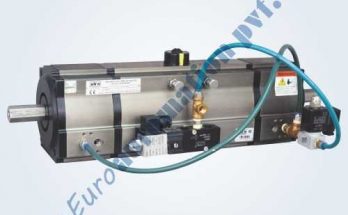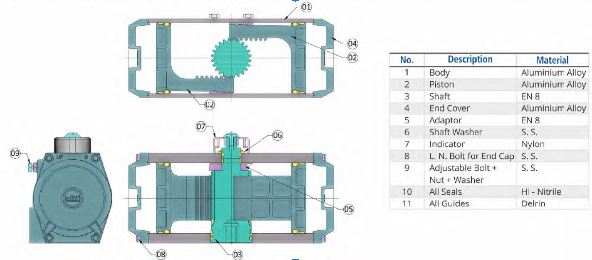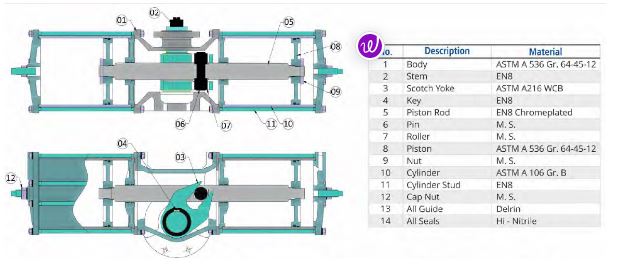How 3 Position Pneumatic Actuator Works, Mechanism & Types

Hello Readers, we are back with an amazing product called a 3 position pneumatic actuator. In this article, we discuss how pneumatic actuators work and what kind of valves they can handle, and how they can work in a corrosive and hazardous atmosphere. Also, we discussed the amazing product, the 3 position pneumatic actuator. So let’s start with the mechanism of a pneumatic actuator.
Mechanism of Pneumatic Actuator
Basically, pneumatic actuators come in two kinds of actuation. Either they are single acting or double acting. The single acting pneumatic actuators are widely known as spring return actuators. Because this type of actuator has a spring fitted on the opposite side of the piston. When pneumatic air pushes the piston from one side, the spring is compressed at the other side, while air supply stops, the spring pushes back the piston to its earlier position. Hence, single acting actuators require only one time air supply to open and close. The double acting actuators required air supply on both sides. First time to push the piston and the second time to push back the piston to its earlier position.
Rack and Pinion Actuator
As the name signified that this type of mechanism works with the help of rack and pinion. There is a linear gear bar called “the rack” that engages teeth on a circular gear called “the pinion”. In response to linear force on the rack, the pinion rotates. The rack is connected to the piston. Hence, the movement of the piston causes the rotation of the pinion and the pinion is connected to an output shaft. Two piston racks moving in opposite directions ensure balanced forces on the pinion by common actuator designs for valve automation. Actuators are typically powered by pneumatic air pressure. Pressure is applied to the piston racks to rotate the pinion.
As the name signified that this type of mechanism works with the help of rack and pinion. There is a linear gear bar called “the rack” that engages teeth on a circular gear called “the pinion”. In response to linear force on the rack, the pinion rotates. The rack is connected to the piston. Hence, the movement of the piston causes the rotation of the pinion and the pinion is connected to an output shaft. Two piston racks moving in opposite directions ensure balanced forces on the pinion by common actuator designs for valve automation. Actuators are typically powered by pneumatic air pressure. Pressure is applied to the piston racks to rotate the pinion.
Scotch Yoke Actuator
The scotch yoke also converts linear motion into rotation through the sliding of a bar back and forth. An eccentric sliding bar is directly coupled to a piston and to a yoke with an engaging slot that rotates the sliding block. The yoke rotates when a force is applied to the piston, causing the sliding block to move in the yoke slot.
The capability of Pneumatic Actuators
The pneumatic actuators allow hands-free remote operation. Hence it can work in a hazardous environment where the human can’t breathe. In addition, the pneumatic actuators offer spark free action that allows controlling the highly inflammable media without the possibility of a fire accident. In comparison to hydraulic actuators, pneumatic actuators perform quickly and compared to electric motorized actuators, pneumatic actuators are low in maintenance and long durable.
3 Position Pneumatic Actuator
The Pneumatic Actuator from Aira Euro Automation has three positions: 0°, 45°, and 90°, or the random position of the middle position. The middle position is achieved by the mechanical brake which is caused by the movement of the two auxiliary pistons. This is a rack & pinion type actuator available in single acting and double acting.
About Aira Euro Automation Actuators
The Aira Euro Automation offers SIL3, ATEX, and CE-approved pneumatic actuators with 4 years warranty. They offer a huge torque range of up to 1,10,000NM with complete automation accessories like Limit Switch, Positioner, FR, etc. Their pneumatic actuators are verified with 5,00,000 cycles.




